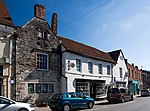Wimborne Minster
Burial sites of the Beaufort familyEngvarB from May 2016Market towns in DorsetTowns in DorsetWimborne Minster

Wimborne Minster (often referred to as Wimborne, ) is a market town in Dorset in South West England, and the name of the Church of England church in that town. It lies at the confluence of the River Stour and the River Allen, 5 miles (8 km) north of Poole, on the Dorset Heaths, and is part of the South East Dorset conurbation. According to Office for National Statistics data the population of the Wimborne Minster built-up area as of 2014 was 15,552.
Excerpt from the Wikipedia article Wimborne Minster (License: CC BY-SA 3.0, Authors, Images).Wimborne Minster
Marlborough Place,
Geographical coordinates (GPS) Address Nearby Places Show on map
Geographical coordinates (GPS)
| Latitude | Longitude |
|---|---|
| N 50.804 ° | E -1.978 ° |
Address
Marlborough Place
Marlborough Place
BH21 1HW
England, United Kingdom
Open on Google Maps









